Test Bank for The Development of Children and Adolescents: An Applied Perspective by Hauser-Cram, Nugent, Thies, Travers
$35.00 Original price was: $35.00.$26.50Current price is: $26.50.
Test Bank for The Development of Children and Adolescents: An Applied Perspective by Hauser-Cram, Nugent, Thies, Travers
Test Bank for The Development of Children and Adolescents: An Applied Perspective by Hauser-Cram, Nugent, Thies, Travers

Product details:
- ISBN-10 : 1118767640
- ISBN-13 : 978-1118767641
- Author: Penny Hauser-Cram
The Development of Children and Adolescents, by Penny Hauser-Cram, J. Kevin Nugent,Kathleen Thies,and John F. Travers, provides an integrated view of child development. Presenting the most pertinent research for each developmental stage and linking this to practical applications in the areas of Parenting, Policy, and Practice, this balanced approach emphasizes the relationship between research and theory and applications. The rich media program, including WileyPLUS with Real Development promotes active learning and allows for increased understanding and comprehension of the course content. The Real Development program is made up of authentic video showcasing real families along with activities and assessments that help students gain an understanding of key developmental concepts. Through the combination of text and media, students are engaged in meaningful learning that deepens and enriches their understanding of developmental concepts.
Table contents:
Part 1 Introduction
Chapter 1 A Child’s Journey 3
MAKING A DIFFERENCE: All Children Have Birthdays 3
Children and Their Development 4
What is Development? 5
The Study of Development 5
WHEN SYSTEMS CONNECT: Developmental Domains 5
Developmental Epochs: Is Age the Answer? 6
Issues in Development 6
A Child’s Journey in the 21st Century 9
Research Insights: Are Today’s Children More Imaginative? 10
Parenting: Children in the Home 10
Children and Their Cultural Communities 12
Children in a Technological World 13
Culture and Parents‘ Views on Children’s Disabilities 14
Practice: Video Games and Learning 15
Explaining Development: The Theories 16
Psychoanalytically Based Theories 16
Cognitive Theories 18
Learning Theories 23
Ethological Theories 25
Systems Theories 26
Focus On: Urie Bronfenbrenner 28
Asking Questions, Examining Answers 29
The Scientific Method 29
Designing Research Studies 30
Collecting Data 37
Reporting Research Results 38
Policy: Ethical Considerations 39
Chapter Summary 40
Key Terms 41
Critical Thinking Questions 41
Development 41
Part 2 Biological Beginnings
Chapter 2 Biological Foundations of Child Development 43
MAKING A DIFFERENCE: It Can Start with Cells 43
The Biology of Life 44
The Functions of Cells 45
DNA, RNA, and Protein 45
WHEN CELLULAR SYSTEMS CONNECT: PKU as an Example 47
Research Insights: “Turning Off” Genes 47
Genes and Heredity 48
Genes and Chromosomes 48
Culture, Genetics, and Human Migration 50
Patterns of Heredity 51
Chromosomal Disorders 56
Parenting: Genetic Counseling 58
Gene-Environment Interactions 59
Mechanisms of Interaction Between Genes and Environment 59
Research on Gene-Environment Interactions: Kinship Studies 63
The Physiology of Thinking and Feeling 66
The Brain and Nervous System 66
The Endocrine System and the Physiology of Stress 72
WHEN SYSTEMS CONNECT: Stress and Child Development 73
Children’s Well-Being in Society 74
Indicators of Children’s Well-Being in the United States 75
Health Care among American Children 75
Policy: Who is Covered by Insurance, and How? 76
Practice: A Hmong Child in the American Health-Care System 77
Chapter Summary 78
Key Terms 79
Critical Thinking Questions 79
Development 79
Chapter 3 Prenatal Development 81
MAKING A DIFFERENCE: Advocating for Care of Pregnant Women 81
Conception 82
Gametes and Meiosis 82
Fertilization 84
Prenatal Growth and Development 85
The Germinal Period: 0 to 2 Weeks 85
Policy: The Politics of Stem Cell Research 86
The Period of the Embryo: 3 to 8 Weeks 87
The Period of the Fetus: 9 Weeks to Birth 88
The Developing Brain: A Closer Look 90
Research Insights: Learning Before Birth 91
Development and the Prenatal Environment 92
Chemical Substances 92
WHEN SYSTEMS CONNECT: Alcohol and Pregnancy 95
Focus On: Ann Streissguth and Fetal Alcohol Syndrome 95
Maternal Disease, Illness, and Stress 97
Environmental Pollutants and Hazards 101
Health During Pregnancy 102
Physiology of Pregnancy 102
Culture and Pregnancy 103
Practice: Recommendations for a Healthy Pregnancy 104
Complications of Pregnancy and High-Risk Pregnancies 104
A Special High-Risk Case: The Pregnant Adolescent 106
Pregnancy and Society 108
Birth-Rate Trends 108
Access to Health Care 108
Infertility 109
Parenting and ART: Telling the Children 113
Practice: Multiple Births 114
Parenting: Health, Family, and Culture 114
Chapter Summary 116
Key Terms 117
Critical Thinking Questions 117
Development 117
Chapter 4 Birth and the Newborn 119
MAKING A DIFFERENCE: An Unexpected Birth Experience 119
Birth 120
What Do You Know About Childbirth? 121
Preparing for the Birth of the Baby 121
Parenting: Writing a Birth Plan 122
Stages of Labor 123
Childbirth and Pain 124
The Place of Childbirth: Home or Hospital? 125
Focus On: Pioneers in the Natural Childbirth Movement 126
Research Insights: Risks in Planned Cesarean Delivery 129
At-Risk Infants: A Different Beginning 130
Prematurity and Birth Weight 130
Causes and Treatments of Prematurity 131
Prematurity and Developmental Outcomes 131
Low Birth Weight in the Developing World 132
A Different Beginning for Parents, Too 132
Research Insights: The Long-Term Risks of Prematurity 133
WHEN SYSTEMS CONNECT: Early Intervention for At-Risk Newborns 134
Focus On: Heidelise Als 134
Neonatal Mortality 135
Policy: The Fourth Millennium Development Goals 137
The Newborn 138
A Dramatic Transition 138
THE DEVELOPING BRAIN: Newborn Reflexes and Behavioral States 139
The Neonatal Behavioral Assessment Scale 141
Sensory Capacities and the Social Newborn 142
The Developmental Tasks of the
Newborn Period 147
The Parent-Infant Bond 147
Breast-Feeding: A Developmental Issue 147
Practice: The UNICEF/WHO Baby-Friendly Hospital Initiative 148
Developmental Tasks Facing the Newborn 149
Research Insights: Effects of Breast-Feeding on Intelligence 150
Culture and Crying 151
Chapter Summary 152
Key Terms 152
Critical Thinking Questions 153
Development 153
Part 3 Infancy
Chapter 5 Physical Development and Health in Infancy and Toddlerhood 155
MAKING A DIFFERENCE: Beating the Odds 155
A Framework for Children’s Health and Physical Development 156
Biology of Health: Physical, Motor, and Perceptual Development 158
New Directions in Infant Motor Research 159
What Happens in the Brain? Beginning to Walk 160
Physical Development: How Babies Grow into Toddlers 162
Motor Development: From Sitting to Jumping 163
Research Insights: Climbing Stairs 165
Theories of Motor Development 166
WHEN SYSTEMS CONNECT: Dynamic Systems Theory 169
Sensory and Perceptual Development: Taking in the World 169
The Developing Brain: Biology of Health 172
An Exuberant Burst of Synapse Formation 173
Focus On: Santiago Ramon y Cajal and Wilder Penfield, Pioneers in Brain Research 173
Research Insights: Mirror Neurons 175
Pruning: Refining the Brain Through Experience 176
Foundations of Health: Nutrition and Health 177
Nutrition for Infants and Toddlers 177
Nutritional Problems 178
Policy: The Special Supplemental Nutrition Program for Women, Infants, and Children (WIC) 179
Capacities for Health: Caregivers, Environment, and Community 182
The Physical Environment 182
The Caregiving Environment 183
Culture and Sleeping Arrangements 184
Parenting: Products for Infants 185
Practice: Infant and Toddler Child-Care Settings 186
Motor Development in Different Cultural Environments 187
Disruptions in Health: Neuromotor Disabilities 189
Cerebral Palsy 189
Muscular Dystrophy 190
Down Syndrome 190
Policy: Early Intervention 191
Chapter Summary 193
Key Terms 194
Critical Thinking Questions 194
Development 195
People also search:
the encyclopedia of child and adolescent development
what is development in child and adolescent
the developing person through childhood and adolescence free pdf
what is child and adolescent development
define child and adolescent development
Related products
Test Bank
Test Bank for Essentials of Business Law and the Legal Environment, 11th Edition: Richard A. Mann











